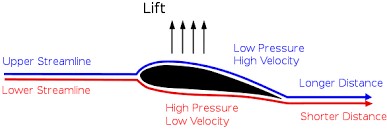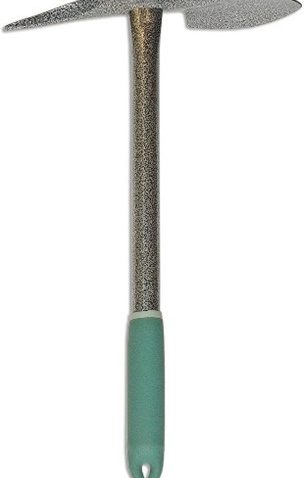
by Stan Logan | Jun 6, 2021 | Trees
This is a science lesson. So if you have no interest in science, stop reading now.
You know the saying, “You cannot keep an old dog from teaching old tricks.” I taught science for 37 years, so I cannot help thinking about scientific principles while gardening. For instance, every time I use my leaf blower to move a stubborn magnolia leaf that my neighbor’s tree has provided, I think about Bernoulli’s Principle. Good old Bernoulli discovered that the faster a fluid moves, the lower the internal pressure. The next time you fly (in an airplane) look at the wing. You will see that the upper surface is curved compare to the bottom surface. This causes the air moving over the top of the wing to travel a longer distance than air beneath it. The air on top therefore has to move faster to get the back of the wing at the same time as the air beneath it. Since the pressure on top is reduced, the greater pressure beneath will lift the wing (and hopefully you along with it).

Bernoulli’s Principle
So why, when I blow air over the top of a magnolia leaf, doesn’t it rise? Well, unfortunately I know the answer. Technically it is called “angle of attack”. (LaVille and I used to fly small planes.) The air blown at the leaf is coming down on it rather than parallel to it. I supposed if I laid the blower down on the ground so that the air flowed along it, the leaf might rise. But that would look stupid, and I get ridiculed enough as it is.
So the next time you are out blowing leaves and a leaf sticks to the ground so you have to go and kick it, yell out “Where’s Bernoulli?” . . Or the next time you are flying along in a plane, say a silent (or loud) thanks to Bernouli. He’s doing a great job of keeping you up.
Stan, The Science Man

by Stan Logan | Nov 28, 2020 | Garden tools, Trees
Perhaps a dozen years ago, LaVille and I planted 12 different fruit trees. We followed the advice of the Dave Wilson Nursery and planted them in 3 groups of 4. There were 4 cherries, 4 nectarines, and a group of 3 pluots with a plum. Each group was growing on the same root stock. The planting pattern was a square with trees 2 feet apart. The goal is to have 4 stunted trees with a varied ripening sequence. Trees were pruned to keep the center of the group open and the height limited to a comfortable harvesting level. Sounds promising, right?
The nectarine trees never produced decent fruit. It may have been related to the fact that I was never able to control the peach leaf curl. So after probably 5 years, I removed them. This wasn’t too difficult, because the root systems weren’t huge.
The cherry trees were doing just fine. Sure, the jays took their toll, but we did have days of human grazing. Then the spotted wing drosophila arrived. The treatment was to apply a spray every 5 days beginning as soon as the fruit showed a blush of color. A couple years of futile effort lead to tree extermination. This was not easy as the biggest trunk was probably 8 inches across. My tools this time were a hand saw, shovel, and hatchet. I won the battle, but there were times when the desired outcome was in doubt.
The 3 pluots and plum trees produced mixed results. The Montgomery plum was just OK. 2 of the pluots produced very little fruit. The Dapple Dandy produced an abundant crop each year. The fruit was large and had a marvelously tasty, sweet flavor. Then disaster struck. Remember that the center of the group is pruned to keep it open, so all of the fruit is produced on the outside of the grouping. Well, even after extensive fruit thinning, the Dapple Dandy had so much fruit on one side, that the trunk cracked open. That was also the straw that broke the camel’s back. All 4 trees were sentenced to termination. Being now an experience henchman, I added 2 tools to my arsenal. Most importantly was the reciprocating saw. It easily chopped off branches and shortened the trunk. It was indispensable for cutting through the roots which were large and intertwined with the roots of the other trees. Not only that, but unlike the cherry trees, these trees had a tap root which required me to excavate extensively to gain access to them. I found that a planting pick was useful for clearing soil away from roots to expose them for the saw blade. It is unavoidable to keep the saw blade away from the soil. I fortunately had bought a package of 5 9” blades, because the soil really dulled them fast. You can tell a blade needs replacing when it not only doesn’t cut, but the friction of the dull blade starts producing smoke. Even with these tools the task was difficult. I could only manage one tree per day.
In the end I did, of course, prevail. Now there is room for planting more irises, which is a good thing as LaVille has probably 30 or 40 growing in gallon pots. 
Now, concerning tools, I have discussed both the transplanting shovel which I used and the reciprocating saw in previous articles. The saw is a must if you have serious tree work to do. I would recommend the little light weight planting pick if your soil is light. I have also found it useful for digging shallow trenches to bury drip lines. Most similar models are heavier and have a squared off chopping blade. The Planting Trenching Digging Garden Hand Tool from Amazon pictured below is like the one I used.
So . . . what does all of this have to do with hating trees? “Hate” is perhaps too strong a term for my attitude toward trees, but you can perhaps understand why I have a somewhat negative attitude. No one enjoys failure—least of all me.
Stan, The Tool Man
by Stan Logan | Nov 19, 2020 | Trees
I can almost hear you screaming: “I suppose you hate oxygen as well!” No. I don’t hate oxygen—I love oxygen. And I appreciate the fact that 28% of the oxygen we breathe comes from trees—particularly trees of the rain forests. (If you don’t know the source of most of the Earth’s oxygen, you will have to do some sleuthing.) Now that I hopefully have you hooked, let me ask you this: Don’t you actually hate trees when Fall arrives and the leaves cascade endlessly into your yard. If it’s not your trees, it’s the trees of your neighbors. Perhaps I’m under particular duress. We have a huge hackberry tree that we planted at the southwest corner of the house 50 years ago. I can accept the cost of the systemic that I have to apply each year to combat the wooly aphid. With reluctance, I accepted the bill of $1050 for thinning the tree a month ago. And I appreciate the shade that the tree provides on hot summer days. But what I don’t appreciate or accept is the mess created every year come about Thanksgiving time—no thanks for giving me all those leaves.
Now you’re probably saying: “Why don’t you simply regard those leaves as valuable additions to a compost pile. First of all, I have no room for a compose bin. Every square foot of my back yard is already occupied. Second, I have tried composting in the past and was a complete failure. Every year all leaves are piled in the street to be picked up by the claw and then composted by someone who knows what he is doing.
Perhaps you think I may of a touch of OCD. You are probably correct. I remember going around the yard with a vacuum cleaner and picking up hackberry leaves one at a time. Well, those days are long gone. I get great satisfaction in mowing up all the leaves that fall on the lawn. I guess I’m just a cleanaholic. Since it seems that’s not all bad considering how much of our waking hours is spent cleaning something—whether it’s your car, your house, your dishes, your clothes, your teeth, or . . . you know what else.
I don’t really hate trees all the time. ‘tiz the season.
Stan, The Not A Tree Hugger Man
P.S. My editor says I’m just a Leaf Grinch.



